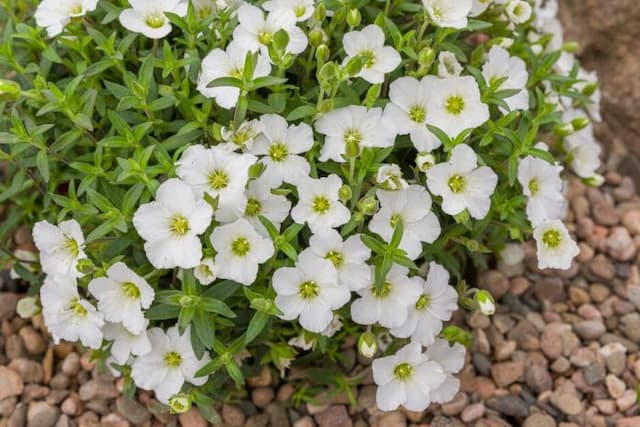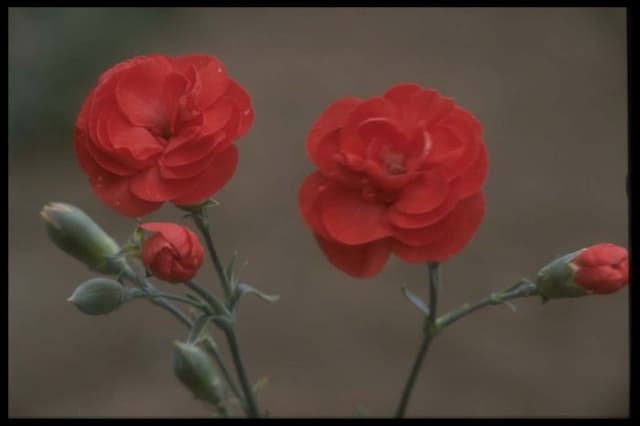Pink Dianthus Pop Star = 'Wp04 Esther' (PBR) (p)
![pink [Pop Star]](/_next/image?url=https%3A%2F%2Fplants-admin.emdemapps.com%2Fimages%2Fplants%2F%2Fimages%2F604b5ba7956c3.png&w=3840&q=75)
ABOUT
The Dianthus 'Pop Star' is a striking plant known for its vibrant flowers and lush foliage. The flowers are particularly notable for their ruffled edges and often display a mix of pink, cerise, and purple hues, with the potential to have a lighter or white 'eye' at the center that creates a striking contrast. Each bloom is distinct, yet they all contribute to the plant’s overall visual harmony. The petals sometimes have a subtle, sweet fragrance that adds another layer of appeal. The foliage of this plant is typically blue-green or gray-green and forms a dense, low clump. The leaves are slender and may exhibit a grass-like appearance. The combination of the colorful, bright flowers against the cooler-toned foliage makes the Dianthus 'Pop Star' a visually engaging plant. It's often admired for its ability to provide a pop of color in garden beds, borders, or containers. It's important to note that while the plant is generally compact, the specific dimensions of the Dianthus 'Pop Star' are excluded from this description in accordance with the guideline to avoid detailing its size.
About this plant
 Names
NamesFamily
Caryophyllaceae
Synonyms
Pink Kisses, Scent First Esther, Scent First Popstar
Common names
Dianthus 'Wp04 Esther'.
 Toxicity
ToxicityTo humans
The Dianthus, commonly known as 'Pinks' or 'Carnations', are typically considered non-toxic to humans. If Dianthus 'Pop Star' shares the same characteristics as other members of the Dianthus genus, it is not expected to be poisonous if touched or ingested. However, sensitivity varies with each person, and any plant might cause a reaction in certain individuals. If someone were to ingest a significant amount of this plant and experience an adverse reaction, it is best to consult a medical professional.
To pets
The Dianthus, known commonly as 'Pinks' or 'Carnations', are generally considered to be non-toxic to pets. This suggests that the Dianthus 'Pop Star' should not pose any significant risk of poisoning if a pet were to ingest it. Despite their non-toxic status, some pets may have a sensitivity or allergic reaction to these plants. If any symptoms of gastrointestinal upset or unusual behavior occur following ingestion, it is wise to consult a veterinarian.
 Characteristics
CharacteristicsLife cycle
Perennials
Foliage type
Evergreen
Color of leaves
Green
Flower color
Pink
Height
1 foot (30 centimeters)
Spread
1 foot (30 centimeters)
Plant type
Herb
Hardiness zones
5
Native area
Europe
Benefits
 General Benefits
General Benefits- Colorful Blooms: Produces vibrant flowers with frilled edges, adding a pop of color to any garden or landscape.
- Long Flowering Season: Offers an extended blooming period from late spring to early autumn.
- Compact Size: With its relatively small size, it is well-suited for borders, pots, and small gardens.
- Low Maintenance: Requires minimal care once established and is relatively drought-tolerant.
- Attracts Pollinators: Flowers attract butterflies and bees, promoting pollination in the garden.
- Fragrant Flowers: The blooms emit a pleasant fragrance, adding another layer of enjoyment to the garden or outdoor space.
- Drought Resistance: Can withstand periods of low water, making it suitable for xeriscaping or regions with water restrictions.
- Cold Hardy: Tolerates cooler temperatures well, making it a good choice for gardens in a variety of climates.
- Deer Resistant: Less appealing to deer, which helps prevent damage to the plant and flowers.
 Medical Properties
Medical PropertiesThis plant is not used for medical purposes.
 Air-purifying Qualities
Air-purifying QualitiesThis plant is not specifically known for air purifying qualities.
 Other Uses
Other Uses- Culinary Garnish: The blooms of Dianthus, also known as Pinks, can be used to add a splash of color and a subtle spicy flavor to salads and desserts.
- Essential Oils: Pinks petals can be processed to extract essential oils for use in perfumery and aromatherapy, offering a sweet and classic fragrance.
- Art and Crafts: Dried Pinks flowers can be utilized in potpourri or embedded into candles and soaps for decorative purposes and to impart their fragrance.
- Fabric Dye: The petals of Pinks can be used to create a natural dye for fabrics, yielding colors in soft pinks and purples depending on the mordant used.
- Bookmark Embellishment: Dried Pinks flowers can be laminated onto bookmarks to create aesthetically pleasing and fragrant reading accessories.
- Floral Waters: Pinks petals can be steeped in water to create mildly fragrant floral waters for use in linen sprays, facial toners, or room refreshers.
- Photography Prop: Fresh Pinks flowers can provide a vivid pop of color and texture as props in still life and macro photography.
- Edible Confetti: Finely chopped Pinks petals can serve as an edible confetti to top cupcakes, cookies, or ice cream.
- Wedding Toss: Dried petals of Pinks are biodegradable and can be used as a fragrant, colorful alternative to traditional rice or confetti for tossing at weddings.
- Plant Dye for Paper: The petals of Pinks can be boiled to make a natural dye for coloring hand-made paper, creating distinctive stationery or craft papers.
Interesting Facts
 Feng Shui
Feng ShuiThe Pink is not used in Feng Shui practice.
 Zodiac Sign Compitability
Zodiac Sign CompitabilityThe Pink is not used in astrology practice.
 Plant Symbolism
Plant Symbolism- Love and Affection: As a member of the Dianthus family, which is commonly known as the 'Carnation' or 'Pink,' this plant often symbolizes love and affection, reflecting the deep emotional bonds and pure feelings one person holds for another.
- Admiration: The striking appearance of the Dianthus Pop Star can signify admiration, conveying respect and high regard for someone's unique qualities.
- Boldness: With its vibrant colors and patterns, the Dianthus Pop Star can represent boldness and daring, indicating a fearless spirit and willingness to stand out in a crowd.
- Distinction: The unique 'Pop Star' quality of this particular Dianthus cultivar suggests a sense of distinction or excellence, symbolizing someone's individuality and exceptional nature.
- Divine Love: Historically, carnations have been associated with divine love, and in particular, the Dianthus Pop Star's beauty could be reflective of an undying and perfect love.
 Water
WaterThe Dianthus, commonly known as 'Pinks', should be watered regularly to keep the soil moist but not soggy. It's best to water these plants when the top inch of soil feels dry to the touch. Depending on the climate and weather conditions, this might mean watering once or twice a week. Utilize a watering can or hose to gently water the plants at the base avoiding the foliage, with approximately one gallon of water per plant for each watering session. During hot and dry periods, you may need to water more frequently to maintain consistent soil moisture.
 Light
LightPinks require a full sun location receiving at least six hours of direct sunlight daily. The best spot for these plants would be in a south-facing garden that has unobstructed exposure to the sun throughout the day. Avoid placing them in areas where they will be in the shadow of larger plants or structures during the prime sunny hours.
 Temperature
TemperaturePinks thrive in temperatures between 60°F and 70°F, which are ideal for their growth. They can survive short periods of colder weather down to about 40°F and can handle heat up to around 85°F. Avoid exposing the plant to temperatures outside this range for prolonged periods to prevent stress and potential damage.
 Pruning
PruningPruning Pinks is important to encourage bushy growth and prolific flowering. Remove spent blooms, also known as deadheading, regularly to promote more flowers. In early spring, lightly prune the plants back by one-third of their height to stimulate new growth. The best time for a more extensive pruning is after the first flush of flowers has faded, usually in late spring or early summer.
 Cleaning
CleaningAs needed
 Soil
SoilThe best soil mix for Dianthus 'Pop Star' is well-draining, loamy soil enriched with organic matter. A pH balance of slightly alkaline to neutral (pH 7.0 to 7.5) is ideal. Amending with compost or well-rotted manure encouraged for optimal plant health and blooming.
 Repotting
RepottingDianthus 'Pop Star' does not require frequent repotting; it should be repotted once every 2-3 years or when it outgrows its current container. Ensure the new pot has adequate drainage holes to prevent waterlogging.
 Humidity & Misting
Humidity & MistingCarnations like Dianthus 'Pop Star' prefer moderate humidity levels, around 40-50%. They do not thrive in overly humid or dry environments, so if indoor air is dry, occasional misting can be beneficial.
 Suitable locations
Suitable locationsIndoor
Place in sunny spot, ensure pot drainage, keep soil mildly moist.
Outdoor
Full sun, well-draining soil, protect in severe frost.
Hardiness zone
5-9 USDA
 Life cycle
Life cycleThe Dianthus 'Pop Star' begins its life cycle with seed germination, typically in early spring under optimal temperature and moisture conditions. Following germination, it enters the vegetative stage, wherein the plant develops its root system, stems, and foliage, a process that can last several weeks. After establishing a strong vegetative structure, the Dianthus 'Pop Star' transitions to the flowering stage, characterized by the development of its signature brightly colored blossoms, often in shades of pink, red, or white, which attract pollinators and can occur from late spring to early fall. Post-pollination, the plant may produce seeds, allowing for self-propagation or seed-collecting for cultivation. Throughout the growing season, Dianthus 'Pop Star' may undergo multiple bloom cycles, especially if spent flowers are regularly deadheaded. As a perennial, the plant will go dormant in the winter season, with above-ground growth dying back and regrowing the following spring from its sturdy root system.
 Propogation
PropogationPropogation time
Spring-Early Summer
Dianthus Pop Star, commonly referred to as Pinks, can be most effectively propagated through the method of cuttings. This process involves taking a healthy, non-flowering stem from the parent plant in late spring or early summer, which is the optimal time for cuttings due to the vigorous growth phase. Cut a 4 to 6 inch (approximately 10 to 15 cm) piece of the stem, ensuring it has several nodes. Remove the lower leaves and dip the cut end into rooting hormone powder to encourage root development. Then plant the cutting in a well-draining soil mix, place it in a warm spot with indirect sunlight, and maintain the moisture without making the soil waterlogged. Roots typically form within a few weeks, after which the new plant can be gradually acclimatized to outdoor conditions before being transplanted to its final location.


![Pink [Tequila Sunrise]](/_next/image?url=https%3A%2F%2Fplants-admin.emdemapps.com%2Fimages%2Fplants%2F%2Fimages%2F604b5d995d06e.png&w=640&q=75)






